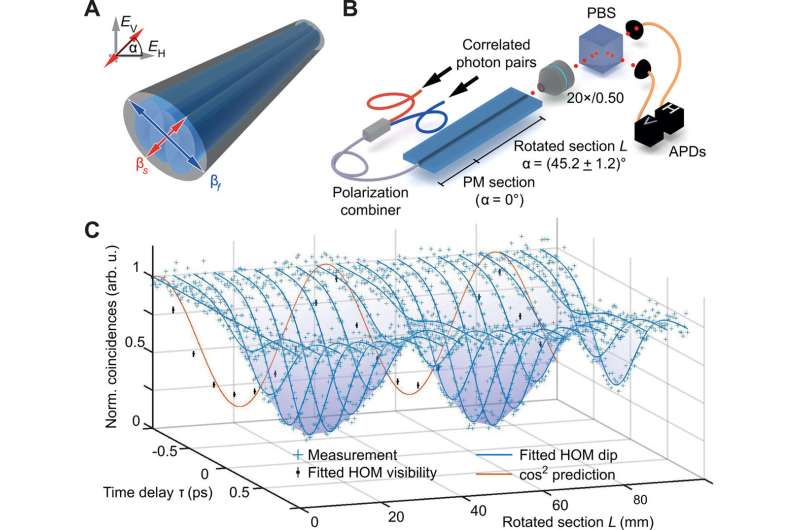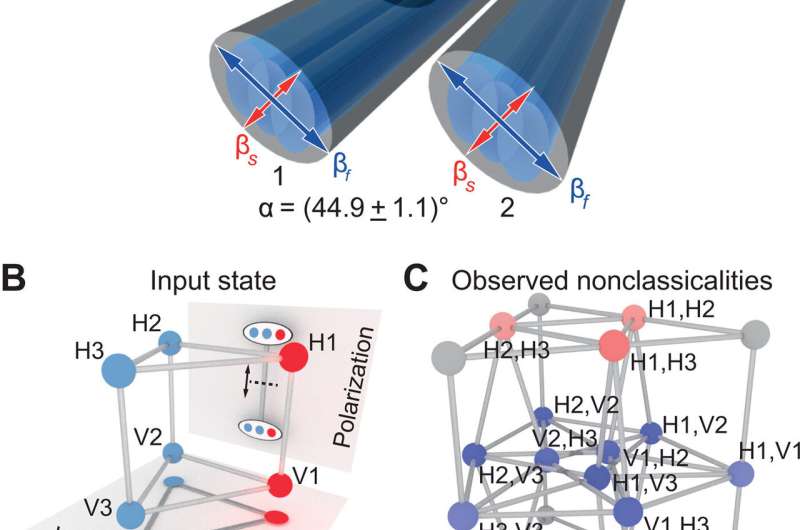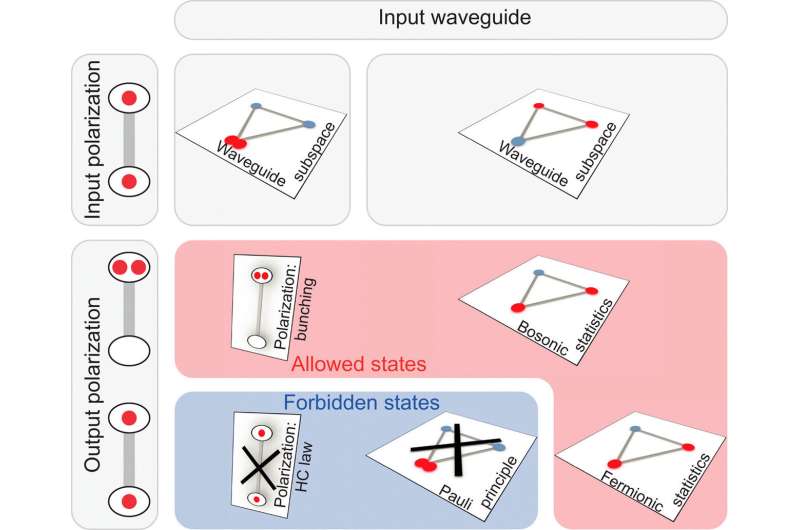March 16, 2021 feature
Exploring complex graphs using three-dimensional quantum walks of correlated photons

Graph representations can solve complex problems in natural science, as patterns of connectivity can give rise to a magnitude of emergent phenomena. Graph-based approaches are specifically important during quantum communication, alongside quantum search algorithms in highly branched quantum networks. In a new report now published on Science Advances, Max Ehrhardt and a team of scientists in physics, experimental physics and quantum science in Germany introduced a hitherto unidentified paradigm to directly realize excitation dynamics associated with three-dimensional networks. To accomplish this, they explored the hybrid action of space and polarization degrees of freedom of photon pairs inside complex waveguide circuits. The team experimentally explored multiparticle quantum walks on complex and highly connected graphs as testbeds to pave the way to explore the potential applications of fermionic dynamics in integrated photonics.
Complex networks
Complex networks can occur across diverse fields of science, ranging from biological signaling pathways and biochemical molecules to exhibit efficient energy transport to neuromorphic circuits across to social interactions across the internet. Such structures are typically modeled using graphs whose complexity relies on the number of nodes and linkage patterns between them. The physical representation of a graph is limited by their requirement for arrangement in three-dimensional (3D) space. The human brain is a marked example of scaling behavior that is unfavorable for physical simulation due to its staggering number of 80 billion neurons, dwarfed by 100 trillion synapses that allow the flow of signals between them. Despite the number of comparably miniscule volume of nodes, discrete quantum systems faced a number of challenges owing to complex network topologies, efficient multipartite quantum communications and search algorithms. However, such physical implementations are thus far constrained to two dimensions (2D). Researchers typically use quantum walks to study the transport properties of connected graphs. For example, they had previously used linear one-dimensional (1D) chains across a range of technical platforms. In this work, Ehrhardt et al. showed controlled quantum walks of correlated photons on 3D graphs. To realize the graph structure, they used a new hybrid approach of 2D photonic lattices of spatially coupled waveguides inscribed into fused silica using femtosecond laser writing. The approach opens new avenues to explore the quantum dynamics of highly complex graphs that play a significant role across numerous scientific disciplines.

Working principle
The setup contained spatially coupled waveguides inscribed into fused silica and a synthetic dimension encoded in the photons' polarization. They established the dynamics within the synthetic dimension by harnessing the intrinsic birefringent properties of elliptical waveguides historically used as polarization active cores of individual single-mode optical fibers. The team arranged for continuous coupling between two orthogonal polarization states to take place within the waveguides relative to an external reference frame. They illustrated the working principle to show the hallmark of two-particle interference using the Hong-Ou-Mandel (HOM) effect, which arose in the polarization degree of freedom of a single waveguide. The direct laser-written waveguides in fused silica were intrinsically birefringent and individually described by a Hamiltonian with bosonic annihilation (creation) operators for photons on the slow/fast principal axis with a propagation constant. They oriented the axes at an angle alpha (α) toward the horizontal or vertical frame of reference. Any deviations in the polarizations states of photons propagating along the z direction according to the Heisenberg equation of motion represented the strength of birefringence - the optical property of the material with a refractive index depending on the polarization and propagation direction of light. This mathematical structure was fully equivalent to the dynamics in a coupled and detuned two-waveguide system. The team used a polarization-duplexed input state synthesized from photon pairs generated through parametric down-conversion (SPDC) and injected it into a polarizaton-maintaining waveguide with an angle of 45 degrees and custom length. Using the experimental setup, the scientists obtained a 2D "HOM landscape" for 20 different lengths.
Extending the system

Based on the existing tools, Ehrhardt et al. extended a system of two spatially coupled waveguides to a square lattice. While conventional waveguide couplers are designed for specific input polarization, the different splitting ratio in this instance was dictated by the difference in polarization-dependent coupling strength between the two channels relative to the photon dynamics within the principal axis. The scientists used a 45-degree rotation of the principal axis, to allow simultaneous spatial coupling and well-defined crosstalk between the polarization states within a given waveguide. They also studied the collective dynamics of two-photon input states for all possible arrangements with at most one photon per site. After the transformation in the square lattice, they separated the polarization components using two on-chip polarization beam splitters and detected the photons subsequently using avalanche photodiodes. For distinguishable photons, Ehrhardt et al. noted equally strong couplings between the lattice sites to form a uniform output probability distribution across the entire lattice. They noted how the destructive and constructive quantum interference caused the full suppression and pronounced enhancement for indistinguishable photons.

Hypercubes and subgraph structures
The team showed how higher-dimensional graphs naturally gave rise to hypercube (HC) symmetries to provide a distinct signature to the evolution of correlated photon pairs. In accordance with the HC suppression law, they noted the emergence of fully destructive quantum interference for two-photon trajectories with specific input-output combinations. Ehrhardt et al. further implemented an experimental 3D quantum walk, in which they transformed an equilaterally coupled triangle of identical birefringent waveguides into a triangular prism. Using the setup, they showed how two bosonic walkers behaved as fermionic walkers on the equilateral triangular waveguide lattice. The division into bosonic and fermionic behavior resulted from a direct consequence of the underlying hypercube structure -similar characteristics can hold for any subgraph structure. As a result, the work indicated how specifically designed waveguide lattices can selectively represent suppression mechanisms relative to bosonic or fermionic two-particle interference on the waveguide subspace.

Outlook
In this way, the exploration of quantum dynamics on complex graphs are important across varied scientific disciplines. However, the increased dimensionality made their experimental implementation ever more challenging. Max Ehrhardt and colleagues introduced a new approach by expanding the dimensionality of photonic lattices via the polarization degree of freedom to increase the vertices' connectivity in space. Based on proof-of-principle experiments, Ehrhardt et al. observed quantum interference in fully controlled quantum walks of correlated photons on 3D graphs—a longstanding goal in quantum photonics. The established framework can allow a number of fascinating opportunities to arise beyond the context of correlated quantum walks. Based on these results, physicists can emulate quantum dynamics of bilayer 2D materials in photonic model systems. The team expect to further examine other nontrivial topologies more efficiently on optical platforms.
More information: Erhardt M. et al. Exploring complex graphs using three-dimensional quantum walks of correlated photons, Science Advances, 10.1126/sciadv.abc5266
Acín A. et al. Entanglement percolation in quantum networks, Nature Physics, doi.org/10.1038/nphys549
Paparo G. D. et al. Quantum google in a complex network, Scientific Reports, doi.org/10.1038/srep02773
Journal information: Science Advances , Nature Physics , Scientific Reports
© 2021 Science X Network




















